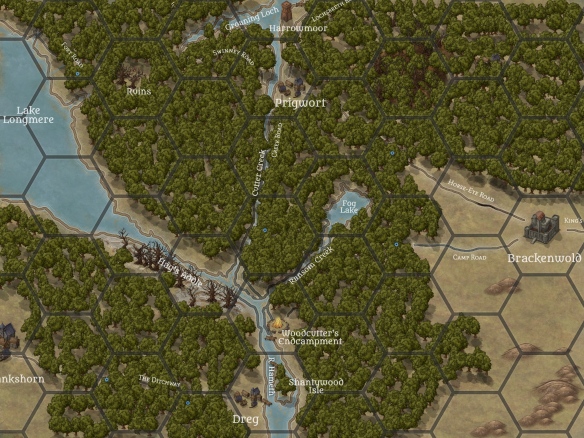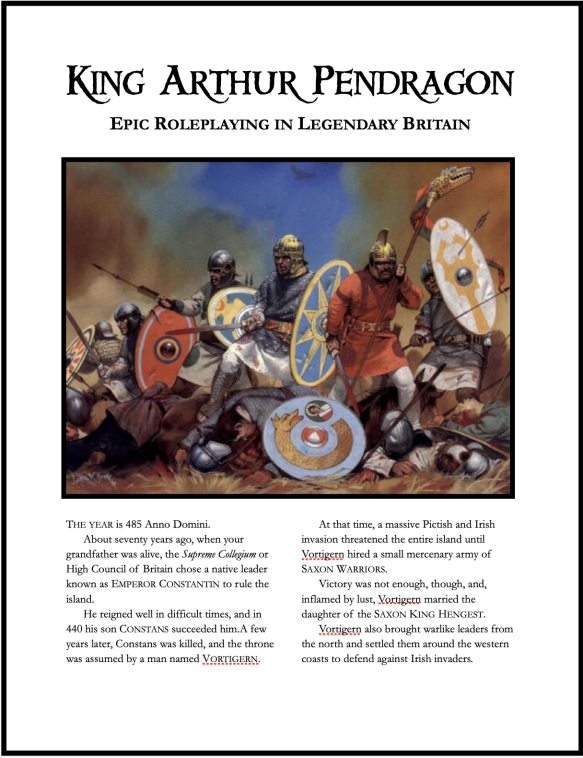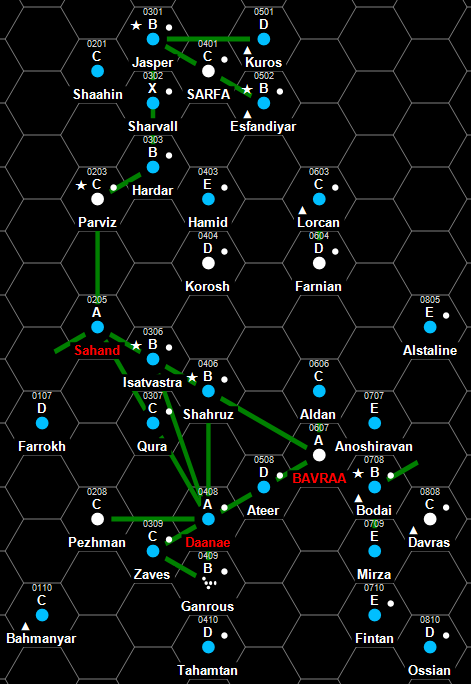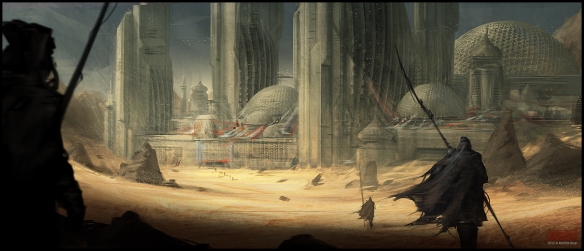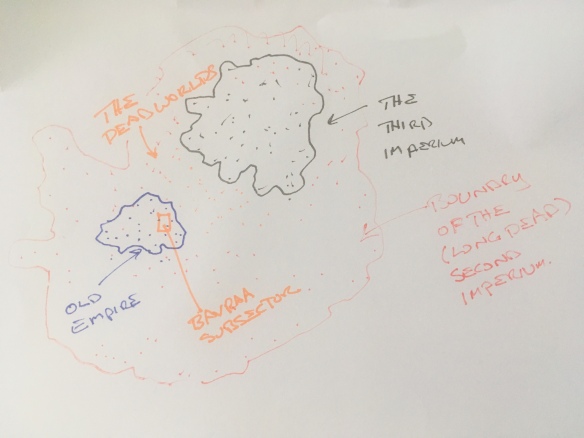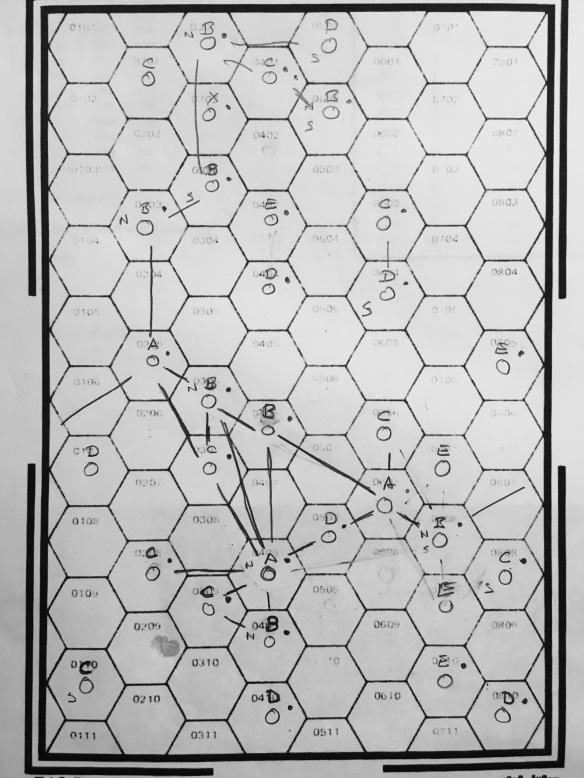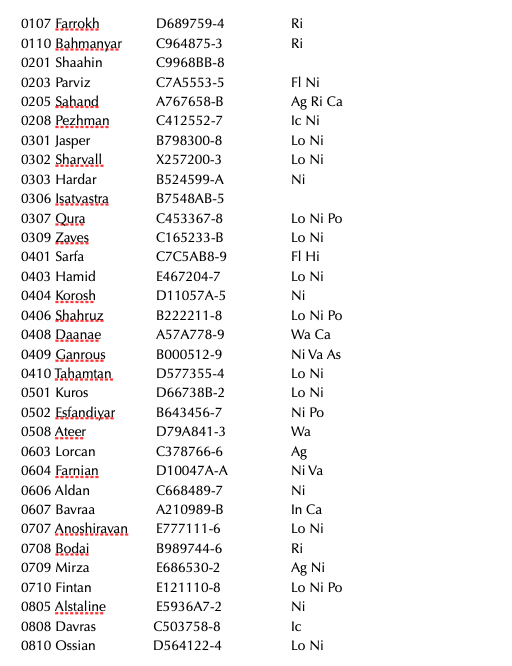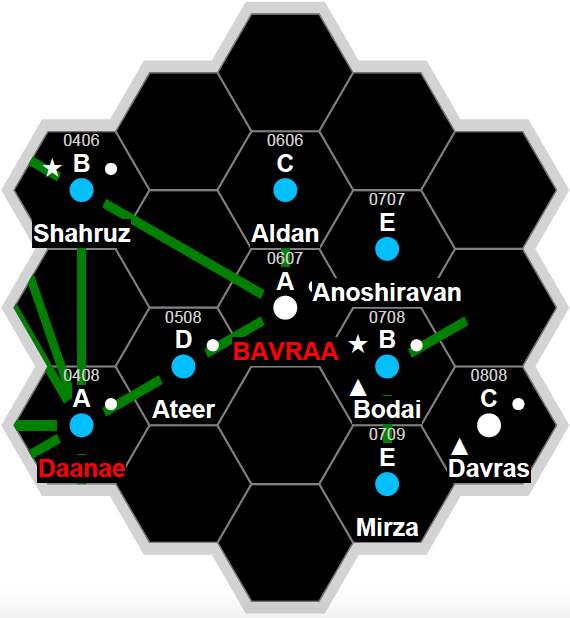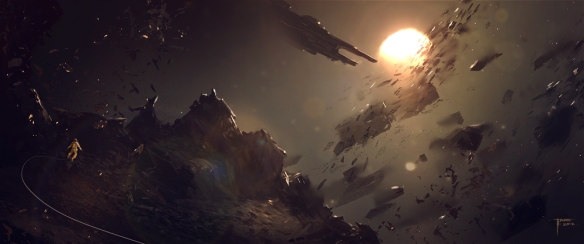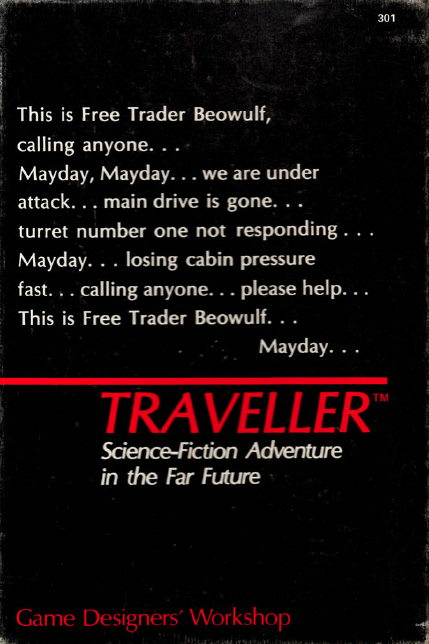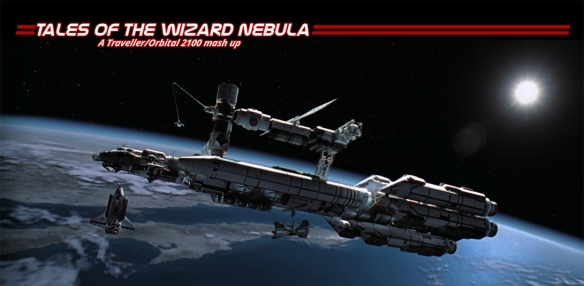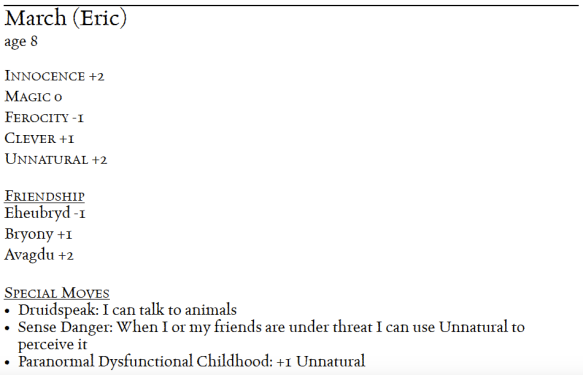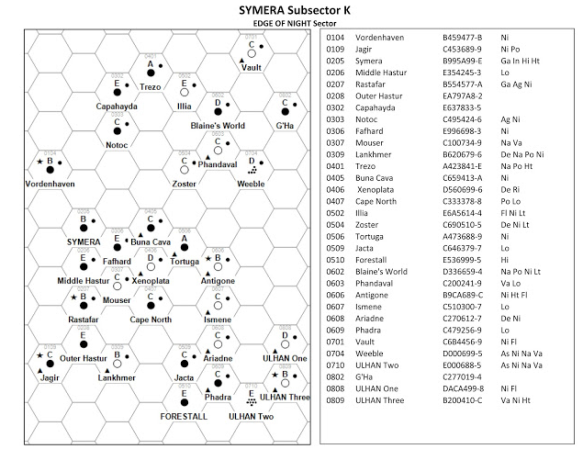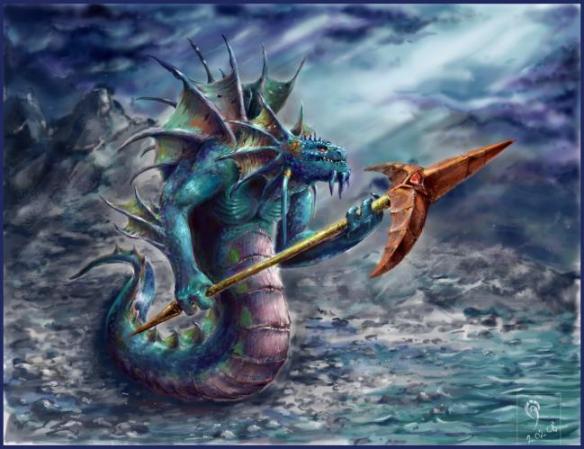
My Lamentations of the Flame Princess Fallen Worlds campaign is still going… but with long breaks on and off. One of the members of the Monday Night Group is in another city at school. And since the pleasure of the game is built from the weird alchemy of the players at the table, I’m content to wait until we’re all gathered. (We got in a few sessions in December when she was back in town on break.)
We keep playing games. All sorts of games! I’ve Refereed a few games along the way as well. (We just wrapped up several months of 5e which was a lot of fun. A lot of heavy mechanical lifting… which was fun! But I’m looking forward to mechanical simplicity again. More on that in posts to come.)
I started typing this post months and months ago, catching up on the Lamplighters as they began their foray into Qelong Valley.
There was a lot of ground to cover. In particular I want to look back at what worked and did not work as I sat myself behind the screen again. Several session have occurred since this post. But I wanted to get this up on the blog!
The Lamplighters made their way up the Qelong River in a boat they bought. They kept two squads of mercenaries they brought with them from earth (or, rather, their earth) and left the rest of them guard the Das Forscher. They reached a poverty stricken village and sought out information about the fortress further upriver they had heard about. But the village was under the control of cannibals who sprang out from hiding when the group was scattered. The combat ranged across the village as the PCs worked to regroup. They ended up losing some of their mercenaries. The found out that the land seemed poisoned by the aakom that powered the magical weapons lobbed over the mountains by the arch-mages fighting their war beyond the Qelong Valley.
I wasn’t particularly happy with this session. It was the second session I had really prepped out a fight and tried to have a set piece of action. (The first was the fight in the village of Bergenzel (aka Scenic Dunnsmouth) and that one went gangbusters.) I think the key is that in this fight they were fighting only for survival after being ambushed (that is, they were only fighting), whereas in Bergenzel they had an actual agenda (find and destroy the Spider Cult). In the Bergenzel fight they had chosen to go after the danger, could decide to press on with things got crazy (and they got crazy) or choose to abandon their goals, they found themselves in the face of multiple factions and had to sort out what was going on in the middle of combat. All in all there was more going on than the fight itself.
So, pro tip to me: A fight for the sake of a fight in and of itself (in other words, survival) is actually kind of boring in an RPG, but a fight where something beyond fighting for survival will be interesting–or at least have a better shot at being interesting.
The Lamplighters continued upriver, but setting their boat ashore and working their way up through some marshland in order to avoid being seen by patrols from Fort Hawk. They saw villagers tending to crops a few hundred yards away. And then they saw Naga-kin (though they had never seen such beasts before so I did not name them) rise up from the waters and attack the villagers.
So, in contrast to the previous fight, the Players/PCs now had a choice about what to do. (Several, really.) They could try to sneak past the Naga-kin. They could engage directly to protect the villagers. They could head back to their boat and try to slip past the Naga-kin on the water. They could retreat from the entire situation. All-in-all, more possibilities and choices.
Also, and I just realized this, the situation was not static as it has been in the village. In the village the the villagers were just going about their business waiting for an opportunity to attack someone. Nothing was in motion, and this cut down on the tactical and strategic elements the PCs could engage with (physically or intellectually) until the trap was sprung. And when it was sprung, the only thing to do was fight for survival. There were no moving part but their own skins.
But in this encounter, the PCs saw first the villagers, then second the Naga-kin attacking them. This meant that right off the bat something was happening that had nothing to do with them. The world was alive with its own energy and motion, and the PCs now had choices to make about getting involved or not.
This is an important lesson I want to carry forward in my own Refereeing: An encounter with a monster (cannibals, for example) is not interesting. An encounter with a situation is interesting.
I’ll point everyone to this post on encounters, particularly the point where Mike Wightman talks about rolling three times on the Classic Traveller Patron table and a final time on the Encounter table. He then lets his imagination cobble together a larger situation using these elements. As he wrote on another website:
Easiest way is with an example (note that this is using the 81 version of LBB3 – Starter Edition and The Traveller Book actually have much more comprehensive tables)
I roll on the patron table and get:
rumour, avenger, army
next I roll on random person encounter
workers, animal encounter (a roll of 6,n I take as animal or alien) and ambushing brigands.
I pick the starting encounter:
Lets say the players encounter some workers who are obviously agitated, discussion with them reveals that the industrial plant they have been operating has been closed due to rumours of some violent native beast, and that some hotheads are thinking of going to hunt the animals down. There is a rumour that the animals in question have highly valuable (insert whatever you want here – anagathic glands, valuable fur, expensive blubber – whatever).
Players may or may not join the hunt, but they have been seen talking to the workers.
Next encounter depends – if they go on the animal hunt then they may encounter the ambushing brigands who are also after the animals, or they may encounter the army patrol guarding the industrial site and containing the animals.
If they don’t go on the hunt they are approached by the avenger who has lost (family member, best friend, whatever will pull players in) and offers to guide the players past the workers/army guards to get to the animals.
If they went along with the workers they may still encounter the avenger being attacked by the brigands/army patrol.
It’s fairly organic – I may decide to change the encounter order in response to player actions, and reaction rolls may make things more tense than they need to be.
And at some point I have to generate the animal stats…
This method reminds me of the terrific work in Hot Springs Island, a rather extraordinary system-neutral OSR setting. (There are no stats in the setting, allowing the Referee to both choose what rules system to use, but to create the difficulty for the party as needed.)
Hot Springs Island is a point crawl of an island of several dozen hexes, as well as several specific sites mapped out in detail (cavern systems, abandoned observatories and so on). The setting has several recursive encounter tables the Referee uses to create encounters either ahead of time or on the fly. But significantly the encounter involve not a single creature or group of creatures, but members of several factions that live on the island in conflict with each other or encountering each other. You don’t just come across an ogre, you come across an ogre battling to take hold a treasure from lizard men.
Note that this makes, again, the environment feel alive. The Players learn about the conflicts between the factions on the island not because the Referee reads them a text box but because they encounter the factions in conflict right before their PCs’ eyes. They can choose to step into the fight on behalf of one side or another in order to gain allies, or to try to wipe everyone out.
Like Wightman’s method quoted above, the setting is not about creatures waiting for the PCs to come along and fight them, but creatures and characters with their own agendas and concerns. By finding them in the middle of their own actions and motivations the world opens up, giving “hand holds” both for information about the world and for the PCs to engage in these lives in motion if they so choose to. This means the game can spin out into unexpected directions.
The fight itself was fun for several reasons:
First, because the Player Characters had chosen to engage the Naga-kin in order to protect the villagers. They want to earn the trust of the villagers to get more information about Fort Hawk, and so they had their own reason to fight. (Instead of fighting only because some random monster wanted to fight.)
Second, the fight was rough. The PCs are now fifth level and had gotten used to their hit points keeping them fairly safe during combat. But the Naga-kin are tough (their high HD gives them bonuses to hit) and they gouged hit points left and right from the party. They were damaging the Naga-kin, but not at a rate fast enough to guarantee they’d survive.
Characters were close to death, some going unconscious, until the magic-user was one of the few characters with full Hit Points. But she had acquired the spell Time Stop back in the village of Bergenzel. She cast it, successfully stopping time in the universe for five rounds just as a Naga-kin was about to pierce here with a trident.
In those five rounds she managed to: Draw and drive her dagger into the neck of the Naga-kin in front of her (killing it), draw a pistol from the Cleric’s brace and fire at another Naga-kin (killing it), and fire Magic Missile at a third (killing it). All in all it was an awesome moment of D&D play.
It also proves my theory that the Referee shouldn’t be too worried about giving out cool candy to the Players Characters. Yes, there will be moments when they are really powerful (Time Stop is powerful!) but the Magic-User can’t cast it all the time and there will be times when pulling out the stops with an extraordinary power not only keeps the party from being wiped out, but allows for a fantastic, cinematic moment to take hold at the table.


